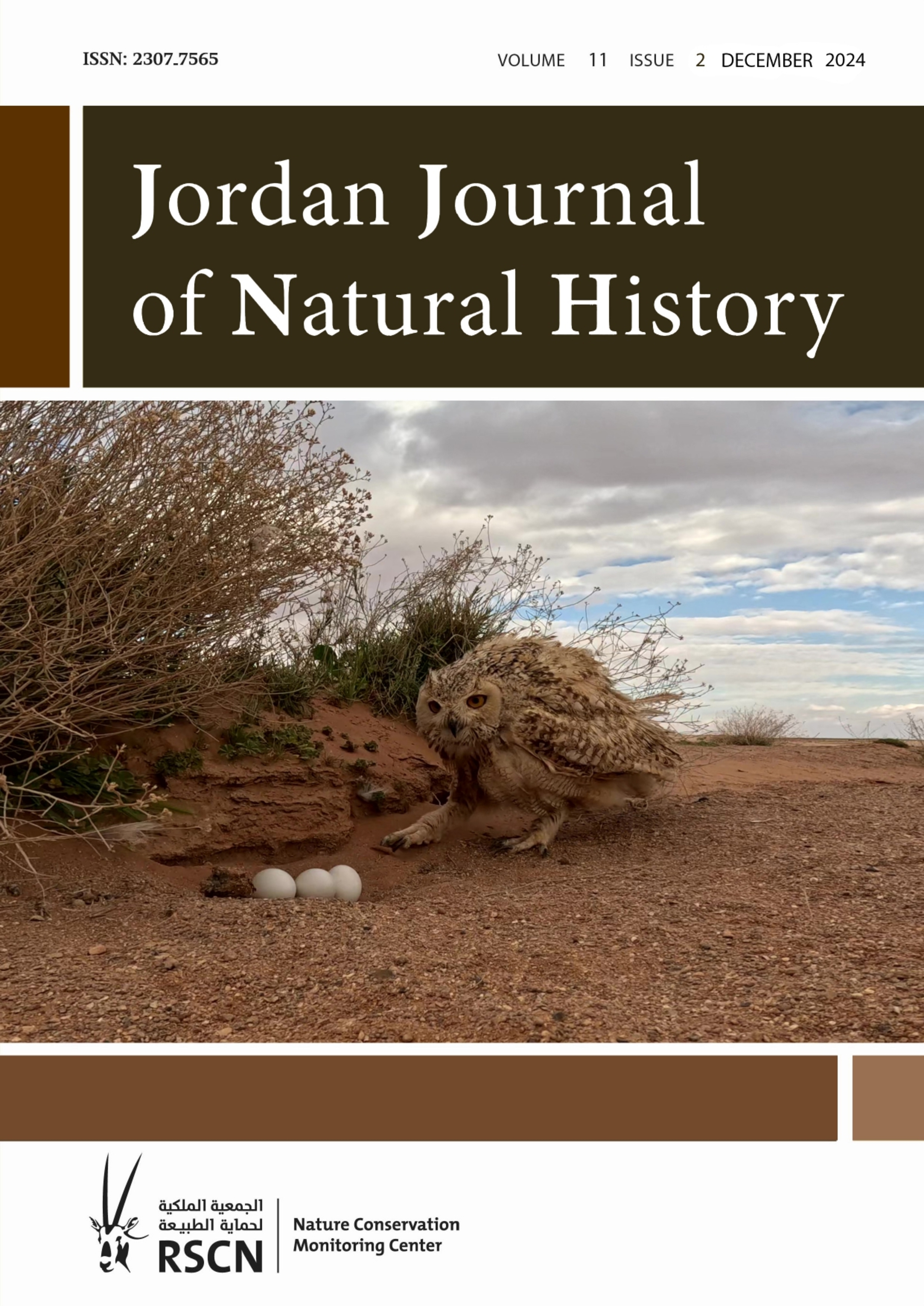Articles
Oecobius putus O. Pickard-Cambridge, 1876 (Araneae: Oecobiidae) in Jordan
Author Name
Hisham K. El-Hennawy
Oecobius putus O. Pickard-Cambridge, 1876, a spider of the family Oecobiidae is recorded from the Dead Sea region in Jordan for the first time. One adult male and one adult female were collected in April 2024 in a resort at the Dead Sea region, Jordan at the lowest place on Earth (altitude -381 m). Its illustrations and measurements are presented below.
A lone Wolf Canis lupus (Linnaeus,1758) Coalition with Feral Dogs in the Kaj Village, Kodinar, Gujarat, India
Author Name
Dhruv Parajapati , Aurobindo Samal and Shreya Pandey
This article presents the first conclusive photographic evidence of a wolf (Canis lupus) in India successfully adapting to coexist with a pack of feral dogs (Canis lupus familiaris). Three photographs were captured in a specific area documenting the wolf’s interactions and behaviors within this unconventional social structure. This observation raises important questions about the adaptability of wolves in changing environments and their potential to form unique associations with domestic species. The findings contribute to the understanding of interspecies dynamics and the ecological implications of such relationships in the wild. Further research is necessary to explore the impact of this adaptation on both the wolf population and the local ecosystem.
Confirmation of the Presence of the Berthold’s Bush Anole (Polychrus gutturosus) on the Nicoya Peninsula, Costa Rica.
Author Name
Gustavo Aguilera Castro, Lucía Isabel López and José Manuel Mora
The Berthold’s Bush Anole, Polychrus gutturosus (Polychridae), is a rare lizard distributed from Honduras to Colombia and Ecuador, where it inhabits rainforests up to 800 m above sea level. In northwestern Costa Rica, it is found in the Guanacaste and Tilarán mountain ranges, with a single report from the Nicoya Peninsula in 2016. However, this locality was not included in the recent description of its distribution. The authors confirm the presence of the Berthold’s Bush Anole in the Nicoya Peninsula with a juvenile found in Hojancha, Guanacaste, 8 km away from the former 2016 observation. This area is located within the Tropical Moist Forest, which means that the Berthold’s Bush Anole has not yet been observed in the Tropical Dry Forest as previously reported. The area of the finding has various anthropogenic uses, with only small patches of vegetation remaining, mainly thorny scrubs.
Checklist and Distribution of Coccinellid Aphid Predators in Tunisia
Author Name
Lassaad Mdellel Sana Zouari, Jouda Guesmi Jouini, Rihem Adouani and Monia Kamel Ben Halima
An extensive survey of aphid predatory coccinellid beetles (Coleoptera: Coccinellidae) was conducted in twenty-seven sites in Tunisia over fourteen years from 2005 to 2019. In total, thirteen ladybird beetles (Adalia decempunctata, Chilocorus bipustilatus, Coccinella algerica, Coccinella undecimpunctata, Coccinella novemnotata, Harmonia axyridis, Hippodamia tredecimpunctata, Hippodamia variegata, Oenopia doublieri, Oenopia lyncea, Myrrha octodecimguttata Linnaeus, Scymnus fulvicollis, Scymnus nubilus) were identified as predators of aphid. Among them, C. algerica was the most abundant predator observed preying on twenty-two aphid species found in twenty-seven sites. The second most abundant predator was H. variegata observed feeding on ten aphid species. Four species (H. axyridis, O. doublieri, O. lyncea, S. nubilus) were the least abundant and were observed only in one site.
Assessment of the Flora and Vegetation of the Shaumari Wildlife Reserve, Jordan
Author Name
Bilal A. Ayasrah, Hothifah Al- Zyout, Asma F. Bzour, Mohammad Al- Zyoud and Laya Majed
The Shaumari Wildlife Reserve, located 120 km east of Amman, is a natural protection site for dry ecosystems. It serves as a complete biodiversity station, with native animals and natural vegetation away from human disturbance. Several Field surveys were conducted in the reserve to collect plant specimens and data on habitat types and plant communities for the sake of mapping them. During this survey, random routes and quadrat analysis were used, and GPS records were taken. A geological map was prepared and modified. The reserve lies across three main formations: Azraq formation (AQ), Fluviatile deposits and gravel of Pleistocene (Pl/ Plg), and Holocene to recent alluvial sediments (Al). Four habitats were identified based on topography, soil type, and the distribution of dominant plant species as follows: Gravel plains with dwarf shrub vegetation habitats, Wadis wih sandy or gravel floors, and drainage channels habitat, Wadis with dike wall, and drainae channels and Urban areas.Two main vegetation types were determined in this reserve including Gravel Hammada and Saline vegetation. The reserve has thirteen different plant communities, primarily distributed within the Run-off hamada vegetation. A checklist of 197 recorded species belonging to 125 genera and 35 families has been prepared. Amongst the checklist species, two are globally endangered according to IUCN red list, (IUCN, 2024),namely Bellevalia warburgii and Euphorbia grossheimii. At the national level, seventeen rare species were recorded, and eleven species were endemic to Jordan. In addition, there were two species that are considered invasive plant species; Xanthium spinosum and Xanthium strumarium and are distributed in the northwest of the reserve.A total number of seventy-five plant species were collected and recorded from twenty-one quadrats. The analysis showed that Anabasis articulata scored the highest frequency value among the perennial species, while the highest density was recorded for Atriplex halimus, and the highest abundance was for Halogeton alopecuroides. Specimens of the collected plant species have been deposited in the Royal Society for the Conservation of Nature RSCN/NCMC Herbarium.
Microalgae Diversity and Water Quality Assessment across Seven Hydro Systems in the Lower Sahara Wetland Complex, Algeria
Author Name
Cherif Ghazi and Abdelkrim SI Bachir
The present work is aimed at establishing, for the first time, the ecological inventory and spatial distribution of the microalgae population in the wetlands of the Lower Sahara eco-complex. Water quality monitoring was carried out on a monthly basis over the period from April 2017 to March 2018 in seven hydro systems in the Lower Sahara wetland complex, while the microalgae sampling was carried out in April 2018. The results obtained indicated that the waters of the study sites did not present a clear thermal stratification and were moderately alkaline to alkaline pH, slightly brackish to very brackish, and generally clear. pH, turbidity, and salinity varied significantly depending on the study sites. The microalgae diversity revealed thirty-seven genera, thirty-one families, twenty-three orders, and six classes, with dominance in the number of genera belonging to the class Bacillariophyceae with an abundance of 80%. The highest values of total richness, Shannon-Weaver and Equitability indices were recorded at Lake Megarine (S=23, H’=3.33, E=74%). Cluster analysis showed four groups by cutting similar tree at a distance of 0.35, which suggests the significance of both the site typology and water salinity in the distribution of microalgae in the region.
Rodents of Qiddiya, Southwest Riyadh, Saudi Arabia
Author Name
Mounir R. Abi-Said
Rodents play a crucial role in ecosystems, serving as indicators of biodiversity richness and as essential components of the food web. They serve as prey for many carnivorous mammals, snakes, and birds. A study on rodent diversity was conducted in Qiddiya, southwest of Riyadh- Saudi Arabia, near the Tuwaiq Mountain range. A total of 410 Sherman live traps were evenly distributed across forty-one sites to ensure comprehensive coverage of the area and its diverse landscapes. Over 2460 trap-nights, 270 individuals were captured representing eight species from two families. Notably, a small population of S. calurus was documented for the first time in Jabal Al Tuwaiq. This finding underscores the need for further fieldwork and research to enhance the understanding of rodent diversity and distribution in the region.
Breeding Record of Pharaoh Eagle-Owl (Bubo ascalaphus) in the Eastern Desert of Jordan
Author Name
Matar Al-Masaeed, Omar Al-Hazza’a, Nader Al-Ghiath, Tareq Qaneer and Nashat Hamidan




